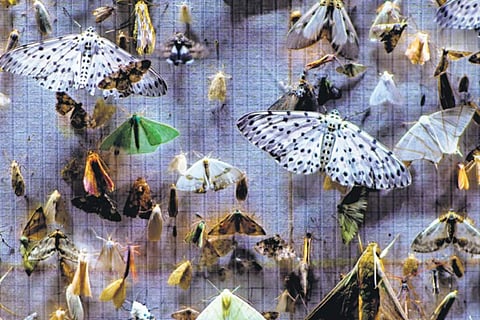
- LIFESTYLE
- FASHION
- FOOD
- ENTERTAINMENT
- EVENTS
- CULTURE
- VIDEOS
- WEB STORIES
- GALLERIES
- GADGETS
- CAR & BIKE
- SOCIETY
- TRAVEL
- NORTH EAST
- INDULGE CONNECT

Nocturnes is immersive, experiential cinema at its most hypnotic. Breathtaking visuals and stunning sound design plant the viewer right in the middle of the universe of moths in this rare Indian entomological documentary. Filmmakers Anirban Dutta and Anupama Srinivasan follow ecologist Mansi Mungee and her assistant Bicki in their quest into the dense forests of Arunachal Pradesh to shine a light on the secret lives of moths. The intimate peep into the world of insects is juxtaposed against the overwhelming expanse of nature. There is also the tireless, laborious work and extraordinary commitment of the researchers.In a conversation with TMS, after the film’s premiere at the Sundance Film Festival, Dutta and Srinivasan dwell on what went into its making.
Excerpts:
Nocturnes is about a unique subject—the inner lives of moths. What took you to it?
Anirban: We have lived for a long time in Delhi. The sheer noise level that we experience there is cacophonic. There is a constant hum even when you listen to music at home. We’ve both felt that there is something very basic that has been taken away from us. We were thinking of making a film which would help us reconnect with nature and to some simple sounds like that of the water droplets or of the wind. We had a chance encounter with Mansi [Mungee] in Uttarkashi, where she told us about this incredible landscape, how she puts up these moth screens and how thousands of moths slowly come down on it.
It’s a subject we don’t associate Indian documentaries with…
Anupama: There has been a tendency to feel that film festivals, especially in the West, will accept Indian documentaries only if they are about a very serious social issue or about somebody fighting against the corrupt system. This was also at the back of our minds—why should we, as filmmakers, feel compelled only to talk about certain issues and only in certain forms? So, in this film, we haven’t followed any template. The story is very basic and simple. So, we could really get into the sound and the visual exploration in a very wonderful and detailed way.
How much did you have to travel, and how long did it take you to shoot the film?
Anirban: The moth work is seasonal. It doesn’t happen in winter, and it was very difficult for us to film during heavy rain. So, it was over a few trips between 2019 and 2023.
Anupama: But the primary, principal photography started by the end of 2021. We followed them [Mansi, Bicki and team] wherever they went but it was all in a relatively small area of the Eaglenest Sanctuary, and the surrounding forests, in the West Kameng district of Arunachal Pradesh. A lot of it is in the community forest and some of it is in the sanctuary.
The film makes for an incredibly immersive experience. What went into its visual language and sound design?
Anirban: In 2019, we went to the forest with the kind of equipment we usually take for documentary shoots—shotgun, boom microphones, lapels, etc. When we came back and heard and saw the footage, we felt what we had been hearing there was not coming across in the footage. It felt like a big loss. At that point, we started researching how to record the sound. We had a wonderful sound recordist, Sukanta Majumdar, who teaches at SRFTI (Satyajit Ray Film and Television Institute). When we went there next, we went with multiple microphones. We did hours and hours of recording. For example, in the film, when you see a transition from day to twilight to night, it is the recording of how the soundscape changes. We wanted to be true to that, and not use any stock, what we call the library sound effects. So, the thunder that you hear, the raindrops that you hear, they’re all from that place. You will see more if you hear more. and if you see more, then you will hear more. This film is as much about sound as it is about images.
Anupama: We were fortunate that from the very beginning, we had Satya [Rai Nagpaul] on board. Apart from being an amazing camera person, he is very interested in entomology. We didn’t want to make picture postcards kind of images at all, even though the forest is so beautiful. We wanted to find another way to capture that beauty. There are many shots of the fog just shifting and changing the way we look at something. The fog played a very important part because it gave a sort of dynamism to even very quiet-looking shots. I think a very crucial aspect was how to film the forest in a different way. One which is very meditative, deep and moving, and not flashy. We decided not to go for a very shallow depth of focus in which we are isolating either the people, the moths, or any aspect of the landscape. We wanted to communicate that through our lensing. And so, we see everything in focus and for that, we needed to figure out how much light was needed to have enough depth of field. We had to do many tests... We did use the macro lens in some shots to get the details of the texture and the little feather and the antenna, which is such a big part of appreciating the moth.
What are the plans ahead for the film?
Anirban: Anupama and I dream of releasing the film in India. Forests are disappearing, environment and nature are being taken away from us. We want to bring awareness of this reality to our children and young people.